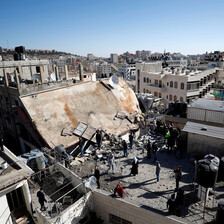The Electronic Intifada 13 June 2016
“The project was about symbolizing the refugees living in the camp as fish,” artist Alaa Albaba says of a recent series of paintings.
Albaba takes up the Palestinian who lived on the coast before the Nakba — the ethnic cleansing of Palestine by Zionist militias ahead of the establishment of the State of Israel in 1948 — and wound up in a refugee camp, cut off and forbidden from accessing the sea.
The fish that thrashes after being removed from the water serves as a metaphor for life in overcrowded refugee camps.
Sardines packed in tins — like those distributed to refugees by relief agencies after 1948 — are another potent symbol.
Albaba lives in al-Amari refugee camp near the West Bank city of Ramallah. He was born there in 1984 — “the third generation of the family after the Nakba.” His family was expelled from Lydd, now in present-day Israel.
With so many pressing needs in the camp, where poverty and unemployment rates are high, and the infrastructure in need of maintenance, art wasn’t exactly a priority.
“But after a while, art became desirable in this place,” he says.
And there he works, painting fish dreaming of returning to the sea.
Linda Paganelli is a visual anthropologist based in Palestine.





